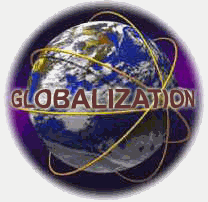HOW BACTERIA COMMUNICATE
January 14, 2007 at 8:46 pm | Posted in Research, Science & Technology | Leave a commentPhilosophical Transactions of the Royal Society B
Royal Society – Publishing – Phil. Trans. R. Soc. B
“Quorum sensing”
How bacteria communicate with each other
http://www.pubs.royalsoc.ac.uk/index.cfm?page=1313
One of the most fascinating discoveries in microbiology is that bacteria communicate with each other. Bacterial communication is called “quorum sensing” because it is a density-dependent process that functions when a population is of sufficient size. It involves the production of diffusible signal molecules that co-ordinate gene expression.
Quorum sensing systems are very widespread and modulate many processes in bacteria that are associated with humans, plants, animals, and which occur in the natural environment.
This issue of the Philosophical Transactions of the Royal Society B features the latest research in quorum sensing – how bacteria communicate with each other, how higher organisms respond to bacterial signal molecules – and strategies to interfere with quorum sensing.
Understanding the role of quorum sensing in pathogenic bacteria offers opportunities to develop novel approaches to combat human, animal and plant diseases. There are wider implications because there is increasing evidence that animals and plants “listen” to bacterial signals and utilise these signals in complex ways. Some plants and animals produce molecules that mimic quorum sensing molecules and so confuse regulation in bacteria. The blocking of cell-to-cell signalling may have evolved as a successful strategy to resist infection by pathogenic bacteria and may be exploitable as we enter the post-antibiotic era.The issue is organised and edited by Ian Joint, J. Allan Downie and Paul Williams.
This issue will be published online early 2007 and in print in mid-2007. To place advance orders for this issue please contact our Sales Office.
For other molecular, cellular and developmental biology issues of the journal, please click here.
For more information on quorum sensing, please visit the University of Nottingham’s quorum sensing site.
Meeting Information
26th – 30th August
Seattle, Washington, USA
3rd ASM conference on cell-cell communication in bacteria
7th – 10th October
Austin, Texas, USA
THE WORLD MONEY MAZE: PROFESSOR ROBERT TRIFFIN
January 14, 2007 at 6:13 pm | Posted in Books, Economics, Financial, Globalization, History, Research, USA | Leave a commentRobert Triffin
Belgian-born Yale economist. In his 1940 work on imperfect competition, Triffin developed fundamental criticism of Chamberlin’s theory. Later gained prominence with his work on international monetary policy.
Robert Triffin 1911 – 1993
Robert Triffin was born in Flobecq, Belgium. He was educated at Kain-lez Tournai, the Catholic University of Louvain and Harvard University. He was an Instructor at Harvard from 1939 to 1942.
In 1942 he left Harvard to become the Chief of the Latin American Division of the government’s Federal Reserve System, and changed his interests from price theory to monetary and banking reform. In 1946 he left to become Director of the Exchange Control Division of the International Monetary Fund (IMF) 1946 – 1948, and chief representative in Europe 1948 – 1949. He was the Special Policy Adviser to the Economic Co-operation Administration and US Alternate Representative to the European Payments Union 1950 – 1951.
Triffin was consultant to the UN in 1952, the Council of Economic Advisers (US) 1953 – 1954, the Organistion of European Economic Co-operation (OEEC) 1957 – 1958, and the EEC 1958 – 1993 as well as heading numerous monetary and banking reorganisation missions to Latin American countries.
In 1951 he returned to academic life as Professor of Economics at Yale University where he remained until his retirement in 1977. He moved back to Belgium to teach part-time at his alma mater, the Catholic University of Louvain.
Major works of Robert Triffin
- Monopolistic Competition and General Equilibrium Theory, 1940.
- Europe and the Money Muddle, 1957.
- Statistics of Sources and Uses of Finance, 1948-1958, with Stuvel et al., 1960.
- Gold and the Dollar Crisis: The future of convertibility. 1960. Robert Triffin
- “Integration economique europeene et politique monetaire”, 1960, Revue Econ Politique
- The Evolution of the International Monetary System. 1964.
- The World Money Maze: National currencies in international payments, 1966.
- Our International Monetary System: Yesterday, today and tomorrow. 1968.
- “The Thrust of History in International Monetary Reform”, 1969, Foreign Affairs
- “The Use of SDR Finance for Collectively Agree Purposes”, BNLQR
- “Lettres au General de Gaulle”, 1973, Espoir
RATAN TATA
January 14, 2007 at 5:34 pm | Posted in Asia, Economics, Financial, Globalization, History, India, Research | Leave a commentSir Ratan Tata
http://www.srtt.org/info.html#3
Sir Ratan Tata Foundation at the London School of Economics & Political Science
About Sir Ratan Tata
The founder of the Tata Empire, Jamsetji Tata, was a true nationalist who foresaw the significance of the industrial revolution for India. He had a desire to catapult India among the leading industrial nations of the world. Sir Ratan Tata, the younger of the two sons of Jamsetji Tata, was born on 20th January 1871. He was educated at St. Xavier’s College in Bombay. Being a director in most of the Tata promoted companies, he naturally took a keen interest in them. After his father’s death in 1904, Sir Ratan along with his elder brother Sir Dorabji followed in the footsteps of their father, in looking after the Tata industrial units with an animated national outlook. Inspired by the thinking of their father, both the sons sincerely believed that in doing so; they were contributing to India’s industrial growth, out of national interest. Thus, the Tata Iron and Steel Co. Ltd., the three Hydro companies and the four Textile Mills were considered by the public as examples of India’s national effort at industrial development.
Sir Ratan was extremely kind hearted and generous, always willing to lend a helping hand to any individual or institution in distress. He had a true Indian outlook with a nationalistic fervour; yet on the other hand, he possessed a balanced, broad-minded mental view-point. Serious charity meant making the effort to identify a cause one deeply cared about, and then devoting time as well as effort and money. In his short, but satisfying lifetime, Sir Ratan had identified several issues, which would bear testimony to his munificence. A glance at donations and endowments made by him during his lifetime, as exemplified below, typifies his concern for various deserving causes, and is an insightful antecedent to the Trust’s present day grant-bestowing policy.
- Servants of India Society
- Mahatma Gandhi and South Africa
- Sir Ratan Tata Foundation at the London School of Economics & Political Science
- Archaeological excavations at Pataliputra in Patna
- Sir Ratan Tata Art Collection
Servants of India Society
The founding of this brotherhood in Poona, on June 12, 1905, was the outcome of Gopal Krishna Gokhale’s convictions that if the masses were to be liberated to function as active members of Free India, they must have a band of selfless and intelligent workers, who would dedicate their lives to the service of the nation. Sir Ratan was a personal friend of Gokhale, and upon the latter’s request, gave the Society an amount of Rs. 10,000 annually, for a period of ten years for its welfare work for the weaker sections of the society. This instance of Sir Ratan’s largesse could be viewed as a precursor to the present grant bestowing policy of the Trust, with regards the issue at hand and the manner in which the same can be effectively addressed.Mahatma Gandhi and South Africa
- Mahatma Gandhi and South Africa
| During his days as a practising barrister in Transvaal, South Africa, Mahatma Gandhi headed a non co-operation movement, protesting against the plight of Asians, and particularly Indians, under the prevailing regime. The movement had run into rough weather with the authorities, leading to persecution of the Indian community. Monetary aid was the need of the hour and Sir Ratan responded generously to a plea from Gopal Krishna Gokhale. Between 1909 and 1913, a total sum of Rs. 1.25 lacs was disbursed by him, in installments, enabling the Mahatma continue his fight for the rights of Indians in South Africa.Overwhelmed by the magnanimity of one such installment made by Sir Ratan, the Mahatma wrote, “That India has been roused is evident from the generous gift of Mr. Ratanji Jamshedji Tata. By his big donation of Rs. 25,000 he has given a powerful impetus to our movement. He will probably be followed by other Indians. Parsis are known the world over for their generous gifts. Mr. Tata has been true to that spirit of generosity.”
Sir Ratan Tata Trust 2005. |
BREAKTHROUGHS MAGAZINE: PNNL
January 14, 2007 at 3:55 pm | Posted in Globalization, History, Research, Science & Technology, USA | Leave a comment
Breakthroughs Magazine
Pacific Northwest National Laboratory
http://www.pnl.gov/breakthroughs
Breakthroughs magazine is published three times a year by Pacific Northwest
National Laboratory, a multi-program research facility operated by Battelle for the U.S.
Department of Energy’s Office of Science.
Lisa Teske, editor
902 Battelle Blvd., K1-39
Richland, WA 99352
Phone: 509.372.6850
Fax: 509.375.6550
lisa.teske@pnl.gov
Business inquiries:
Marketing Communications
1.888.375.PNNL (7665) toll-free
inquiry@pnl.gov
http://www.pnl.gov
Media inquiries:
Media Relations
Phone: 509.375.3776
Fax: 509.375.2242
greg.koller@pnl.gov










